Burma's Cultural Capital
Tuesday 7 December - Saturday 11 December
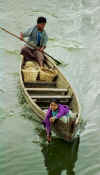 Both
of us had been looking forward to discovering what we could of Burma.
Now officially renamed Myanmar, it has been virtually sealed off from the
outside world since 1962 when a dictatorial regime took control of the
government and economy. It still
remains under tight military rule and although efforts have been made to attract
tourism in recent years, much of the country is still off limits and the
government’s harsh and often inhumane policies have attracted widespread
international criticism.
Both
of us had been looking forward to discovering what we could of Burma.
Now officially renamed Myanmar, it has been virtually sealed off from the
outside world since 1962 when a dictatorial regime took control of the
government and economy. It still
remains under tight military rule and although efforts have been made to attract
tourism in recent years, much of the country is still off limits and the
government’s harsh and often inhumane policies have attracted widespread
international criticism.
We had read the guidebooks prior
to our arrival and had stopped to re-evaluate whether or not we should indeed
visit this controversial yet intriguing country. Many human rights groups urge non-Burmese not to visit
Myanmar, arguing that tourism contributes to government repression within the
country; others believe that people visiting from outside can actually help
educate the world as to what is really going on inside the country.
On balance we decided to go, and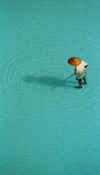 despite stories from fellow travellers about US citizens being refused visas or
foreigners only being allowed in if on a government-approved tour, we had
surprisingly little trouble acquiring visas from the Burmese Embassy in Bangkok.
For us, the objective in visiting Burma was to discover what we could of
their culture and history – good or bad, for better or worse – and we hoped
that by deciding to opt away from government owned hotels, travel agencies and
transportation, a portion of whatever money we did spend would go to some of the
good-hearted Burmese citizens who try to eke out a living from
what little tourism exists.
despite stories from fellow travellers about US citizens being refused visas or
foreigners only being allowed in if on a government-approved tour, we had
surprisingly little trouble acquiring visas from the Burmese Embassy in Bangkok.
For us, the objective in visiting Burma was to discover what we could of
their culture and history – good or bad, for better or worse – and we hoped
that by deciding to opt away from government owned hotels, travel agencies and
transportation, a portion of whatever money we did spend would go to some of the
good-hearted Burmese citizens who try to eke out a living from
what little tourism exists.
We arrived into Rangoon by late
evening. The sight at the airport upon arrival was somewhat
depressing. Amid an acute feeling
of oppression, surrounded by so many uniformed guards and watched and assessed
by so many pairs of eyes, we were initiated into our first example of government
repression. We were greeted
on the other side of customs by a sea of young, eager faces (mostly of student
age) all of whom were obviously delighted by the sight of two independent
travellers seeking a taxi ride into town, but who were just as obviously trying
to hide their eagerness.
This was not the mad dogfight you would expect somewhere like India, where
a general free-for-all would ensue involving pushing, shoving and any other
means available to get you into their taxi and not the guy’s next to them.
It was a very sedate, almost silent advance on their part, simply
positioning themselves behind the barrier, shoulders hunched hoping you would
catch their eye and ask them for a lift into town.
Despite their reticence, taxi fares into town were obviously much sought
after and one or two younger guys would occasionally give a furtive wave after
looking around surreptitiously to check he wouldn’t be seen, presumably by
army officials or government informants. We
may have been in the country only a matter of minutes, but we were already in
absolutely no doubt that people were on a very short leash.
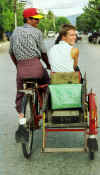 For the most part, we were
pleasantly surprised at how friendly Burmese people seemed to be.
Even the taxi drivers were honest! No
doubt this will change as more tourists visit the country and people become more
and more desperate to earn money from the lucrative tourist trade.
But in today’s Burma, it seemed that Buddhist values combined with fear
of the authorities kept people very much on the straight and narrow.
For the most part, we were
pleasantly surprised at how friendly Burmese people seemed to be.
Even the taxi drivers were honest! No
doubt this will change as more tourists visit the country and people become more
and more desperate to earn money from the lucrative tourist trade.
But in today’s Burma, it seemed that Buddhist values combined with fear
of the authorities kept people very much on the straight and narrow.
After
just three days in Rangoon making travel arrangements and exploring a few sights
(we would be back for more later), we flew north to Mandalay.
Having read accounts by both Orwell and Kipling (who had apparently never
even been there), we were expecting a city of romance, mystery and intrigue.
What we found was a sprawling town with dry and dusty streets and
stunning pagodas, but even these didn’t quite seem to live up to their exotic
reputation.
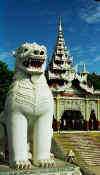 With just over two full days to
explore Mandalay and its surrounds, we hit the sightseeing trail within hours of
landing. Our first port of call was
some of the smaller pagodas closest to our hotel. Setting out on foot, we were approached by a group of
students who seemed keen to strike up conversation with us in surprisingly
fluent English, and asked us about where we had come from and why we had decided
to come to Burma. Initially we were
somewhat skeptical as to their motives, but soon realised that all they wanted to
do was practice their English and, in the process, find out what people outside
of Burma thought of their country. They
indicated frustration at the situation within their country (while insisting
that we must not talk of it to anyone else, lest they be reported) and wanted to
understand what foreigners thought of their government.
Eric, ever the conservative, suggested we should continue on our way but
our new-found friends were not to be put off and tried to enlist a promise from
us that we would meet up with them later and accompany them to their English
class where we could help them and their fellow colleague improve their
conversation techniques!
With just over two full days to
explore Mandalay and its surrounds, we hit the sightseeing trail within hours of
landing. Our first port of call was
some of the smaller pagodas closest to our hotel. Setting out on foot, we were approached by a group of
students who seemed keen to strike up conversation with us in surprisingly
fluent English, and asked us about where we had come from and why we had decided
to come to Burma. Initially we were
somewhat skeptical as to their motives, but soon realised that all they wanted to
do was practice their English and, in the process, find out what people outside
of Burma thought of their country. They
indicated frustration at the situation within their country (while insisting
that we must not talk of it to anyone else, lest they be reported) and wanted to
understand what foreigners thought of their government.
Eric, ever the conservative, suggested we should continue on our way but
our new-found friends were not to be put off and tried to enlist a promise from
us that we would meet up with them later and accompany them to their English
class where we could help them and their fellow colleague improve their
conversation techniques!
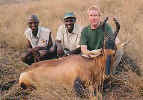 We continued on to see some of
the pagodas listed in the guidebook but found some of what we saw disappointing.
Many of the temples looked as if they needed a facelift; weeds were
growing up among the shrines lining the base of the pagodas, which themselves
looked as if it had come face to face with a coating of
whitewash which had not been particularly caringly administered.
But one gem we did encounter at one of these pagodas was an Englishman by
the name of Iain Cassie, a photographer with a Leica camera Eric came to covet
and a keen sense of humor we both came to appreciate.
But our first encounter was to some degree innocuous and we parted
company not expecting our paths to cross again … how wrong we were!
We continued on to see some of
the pagodas listed in the guidebook but found some of what we saw disappointing.
Many of the temples looked as if they needed a facelift; weeds were
growing up among the shrines lining the base of the pagodas, which themselves
looked as if it had come face to face with a coating of
whitewash which had not been particularly caringly administered.
But one gem we did encounter at one of these pagodas was an Englishman by
the name of Iain Cassie, a photographer with a Leica camera Eric came to covet
and a keen sense of humor we both came to appreciate.
But our first encounter was to some degree innocuous and we parted
company not expecting our paths to cross again … how wrong we were!
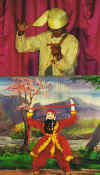 Having
not been particularly inspired by what we had seen so far, we headed for lunch
and once again bumped into Iain. After
a dose of good food and good company, we decided to head back to our hotel but,
reading up on the tradition of Burmese puppetry, opted to venture out again that
evening to see for ourselves what Mandalay Marionette Theatre (yok-thei pwe)
had to offer. Many people consider
this to be the most colourful of all Burmese arts and although once a major
influence in Burmese culture, it is sadly nowadays confined mostly to tourist
venues in a few key centres across the country.
It was a fun display featuring many colorful characters taken from
Burmese and Indian mythology and old folktales.
Once again we caught sight of Iain (what a small world Mandalay was
proving to be) and headed back to our hotel after the puppet show carried along
on bicycle rickshaws courtesy of our student friends we had met earlier that
day.
Having
not been particularly inspired by what we had seen so far, we headed for lunch
and once again bumped into Iain. After
a dose of good food and good company, we decided to head back to our hotel but,
reading up on the tradition of Burmese puppetry, opted to venture out again that
evening to see for ourselves what Mandalay Marionette Theatre (yok-thei pwe)
had to offer. Many people consider
this to be the most colourful of all Burmese arts and although once a major
influence in Burmese culture, it is sadly nowadays confined mostly to tourist
venues in a few key centres across the country.
It was a fun display featuring many colorful characters taken from
Burmese and Indian mythology and old folktales.
Once again we caught sight of Iain (what a small world Mandalay was
proving to be) and headed back to our hotel after the puppet show carried along
on bicycle rickshaws courtesy of our student friends we had met earlier that
day.
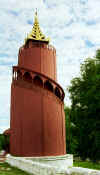 The
next day, we headed out early to take in more of Mandalay’s top tourist
attractions. We explored the
Mandalay Palace and Fort (complete with another Iain sighting), having first to
sign in with the army officials on duty and agree that we would only venture
into those areas that were specifically designated to tourists (previously you
were only allowed inside the fort accompanied by an official tour guide).
We were once again somewhat disappointed by the gaudy and not-so-professional
renovations, presumably scheduled to be completed in time for the 'Visit
Myanmar Year' four years previously. Many of the palace buildings had been reconstructed, and
although accurate copies of the originals, much of the detail was missing.
The
next day, we headed out early to take in more of Mandalay’s top tourist
attractions. We explored the
Mandalay Palace and Fort (complete with another Iain sighting), having first to
sign in with the army officials on duty and agree that we would only venture
into those areas that were specifically designated to tourists (previously you
were only allowed inside the fort accompanied by an official tour guide).
We were once again somewhat disappointed by the gaudy and not-so-professional
renovations, presumably scheduled to be completed in time for the 'Visit
Myanmar Year' four years previously. Many of the palace buildings had been reconstructed, and
although accurate copies of the originals, much of the detail was missing.
To give Mandalay its due,
however, there were a couple of sights we wouldn’t have missed for the world.
The first was the Shwe In Bin Monastery, a spectacular teak building
constructed around 80 years ago by a rich Chinese jade merchant.
It was raised on cream stucco foundations within a sandy, shady compound
and enveloped by a very serene air. There
were some spectacular examples of Burmese-style carved doors and other
wood-carvings that showed in great detail the quality of workmanship in years
gone by. It was here that we
encountered the head monk, U Sujana, who educated us on the art of meditation
and invited us back to the main monastery compound to take away a guide of
practical meditation exercises (following exclamations from the two of us that
somehow, all previous attempts to enter the foray of meditative contemplation wound up in the compilation of mental lists detailing what we
needed to get done that day). As we
sat on the floor of a large hall in conversation with U Sujana, a serious and
dedicated monk, his younger disciples would come by to peer in through the open
windows, suppressing their giggles at this (presumably) comical sight.
While we listened intently to him, mosquitoes buzzed around our ears and,
forgetting that all life is sacred, we swatted them as they landed on our
ankles. How easy it is to forget
the teachings of Buddha and how hard it is to follow them!
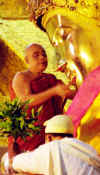 But even more spectacular than
this, and the ultimate highlight of our trip to Mandalay, began with a wake up
call at 3.00am. Our driver came to
meet us at the hotel and, as we made our way through the deserted streets in the
pitch black, there was suddenly a distinct change in activity as we approached
our destination. The Mahamuni
Pagoda is Mandalay’s most fabled religious monument, built in 1784 and
then rebuilt in 1884 following a fire. Inside,
it houses a nearly 4 metre (13 foot) image of the Buddha seated in a recessed alcove,
coated with layer upon layer of gold leaf. So revered is this image of Buddha that each and every day at
4.30am, it undergoes its morning’s ablutions, a ritual that involves a
full facial and teeth cleaning lasting over an hour! This one was not to be missed.
And so, sitting amid hundreds of ardent worshippers (who at that hour in
the morning literally seemed to appear from nowhere), we watched this
spectacular ceremony unfold.
But even more spectacular than
this, and the ultimate highlight of our trip to Mandalay, began with a wake up
call at 3.00am. Our driver came to
meet us at the hotel and, as we made our way through the deserted streets in the
pitch black, there was suddenly a distinct change in activity as we approached
our destination. The Mahamuni
Pagoda is Mandalay’s most fabled religious monument, built in 1784 and
then rebuilt in 1884 following a fire. Inside,
it houses a nearly 4 metre (13 foot) image of the Buddha seated in a recessed alcove,
coated with layer upon layer of gold leaf. So revered is this image of Buddha that each and every day at
4.30am, it undergoes its morning’s ablutions, a ritual that involves a
full facial and teeth cleaning lasting over an hour! This one was not to be missed.
And so, sitting amid hundreds of ardent worshippers (who at that hour in
the morning literally seemed to appear from nowhere), we watched this
spectacular ceremony unfold.
First, the monks arrived laden
with towels, perfume and, most importantly scaffolding which they erected prior
to the arrival of the head monk. The
head monk appeared and, precariously balanced to the side of the Buddha’s
face, he began to wash it using bars of soap and bowl after bowl of piping hot
water supplied by an entourage of monks running back and forth with fresh
supplies. Pile after pile of towels
was lined up for washing (and then drying) the Buddha’s face, followed by
mopping off several generous applications of countless colognes.
It seemed that the larger the laundry bag, the greater the respect that
was paid to this great figure. Following
the face washing, the process of brushing teeth commenced using an oversized
toothbrush. Then, a hairdryer
appeared, attached to several extension cords to dry everything off and finally,
more gold leaf was applied across his face and body to touch up any areas where
the gold may have been getting worn. It was a fascinating spectacle.
Throughout the entire process, people were whispering prayers, offering
gifts and meditating. There was an
eerie silence broken only by the shuffling of feet (all shoes long since
removed) and the clank of meditation beads.
Oh, and of course the click of Eric’s camera!
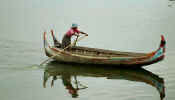
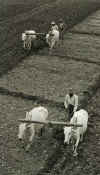 With
the remaining time we had in Mandalay, we managed to squeeze in visits to some
of the ancient cities that can be found within a few hours' drive.
Amarapura, known as the 'City of Immortality' was briefly the capital
of Upper Burma before Mandalay was established.
We arrived there in the early morning and strolled leisurely across the
three-quarter mile long U Bein Bridge, towards the small village of Kyauktawgyi.
There was not much to see in the village itself other than a small white
pagoda hidden behind fragrant frangipani trees, but
the walk across the bridge afforded us some magnificent views of fishermen
trying for their first catch of the day and local villagers trudging behind
their large ox-drawn ploughs, leaving trails of furrowed earth in their wake.
With
the remaining time we had in Mandalay, we managed to squeeze in visits to some
of the ancient cities that can be found within a few hours' drive.
Amarapura, known as the 'City of Immortality' was briefly the capital
of Upper Burma before Mandalay was established.
We arrived there in the early morning and strolled leisurely across the
three-quarter mile long U Bein Bridge, towards the small village of Kyauktawgyi.
There was not much to see in the village itself other than a small white
pagoda hidden behind fragrant frangipani trees, but
the walk across the bridge afforded us some magnificent views of fishermen
trying for their first catch of the day and local villagers trudging behind
their large ox-drawn ploughs, leaving trails of furrowed earth in their wake.
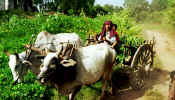 The city of Inwa was perhaps the
most interesting of the places we visited, at least from an historical point
of view.
It was Burma’s capital for a long time after the fall of Bagan. Apart from a few crumbling remains, the most spectacular
sight on offer was a beautiful un-renovated teak monastery. It comprises in excess of 267 teak posts set in the middle of
the great royal rice fields. Now
more a barren plane covered with
The city of Inwa was perhaps the
most interesting of the places we visited, at least from an historical point
of view.
It was Burma’s capital for a long time after the fall of Bagan. Apart from a few crumbling remains, the most spectacular
sight on offer was a beautiful un-renovated teak monastery. It comprises in excess of 267 teak posts set in the middle of
the great royal rice fields. Now
more a barren plane covered with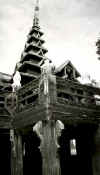 tangled vegetation and dusty earth, its setting is perhaps less spectacular,
but the cool dark interior was definitely intriguing.
Amid the dust and musty smell of stale air and damp, there were several
intricate carvings which were well preserved.
Those on the exterior were equally exquisite and in bare feet, we circled
the outer walls watching monks taking their morning lessons and then taking
their afternoon siesta under the cool shade cast by the vast teak roofing.
tangled vegetation and dusty earth, its setting is perhaps less spectacular,
but the cool dark interior was definitely intriguing.
Amid the dust and musty smell of stale air and damp, there were several
intricate carvings which were well preserved.
Those on the exterior were equally exquisite and in bare feet, we circled
the outer walls watching monks taking their morning lessons and then taking
their afternoon siesta under the cool shade cast by the vast teak roofing.
Our
last port of call before leaving Mandalay was the hill station of Maymyo.
In 1886, following the British takeover, it became an army base but once
its climatic advantages became apparent to the British, it grew into a popular
hill station.
The first part of the drive there from Mandalay went through flat
expanses of rice fields but then the landscape changed dramatically as we began
the climb up the mountain and huge fronds of bamboo and toddy palms cast shadows
across the road.
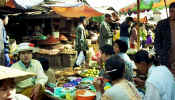 On the outskirts of the town
were
several English-style houses surrounded by very English-looking gardens.
At the centre of town was a large clock tower (deemed to be a sure sign of
English colonial town planning) and although many of the buildings appeared to
be Burmese in style, the shop names gave away the decidedly English influence
that surrounded this town’s development.
The market
was a spectacular jumble of stalls selling food-stuffs, household goods and
clothing and was characterized by the usual hustle and bustle of people touting
their wares amid sounds of chickens squawking and car horns sounding on the
neighboring streets.
On the outskirts of the town
were
several English-style houses surrounded by very English-looking gardens.
At the centre of town was a large clock tower (deemed to be a sure sign of
English colonial town planning) and although many of the buildings appeared to
be Burmese in style, the shop names gave away the decidedly English influence
that surrounded this town’s development.
The market
was a spectacular jumble of stalls selling food-stuffs, household goods and
clothing and was characterized by the usual hustle and bustle of people touting
their wares amid sounds of chickens squawking and car horns sounding on the
neighboring streets.
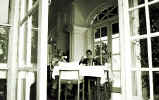 Another landmark was the former
British bachelor’s quarters of Candacraig, an old Tudor style house now owned
by government and run as a hotel. Not
a particularly luxurious one, however, and even indulging in the
great British tradition of taking tea there was a major disappointment.
But it was a pleasant day trip and, as usual, Pippa was happy to see
another part of her great British heritage.
But it was time to move on and later that afternoon, we were on another
internal flight heading west to Bagan.
Another landmark was the former
British bachelor’s quarters of Candacraig, an old Tudor style house now owned
by government and run as a hotel. Not
a particularly luxurious one, however, and even indulging in the
great British tradition of taking tea there was a major disappointment.
But it was a pleasant day trip and, as usual, Pippa was happy to see
another part of her great British heritage.
But it was time to move on and later that afternoon, we were on another
internal flight heading west to Bagan.